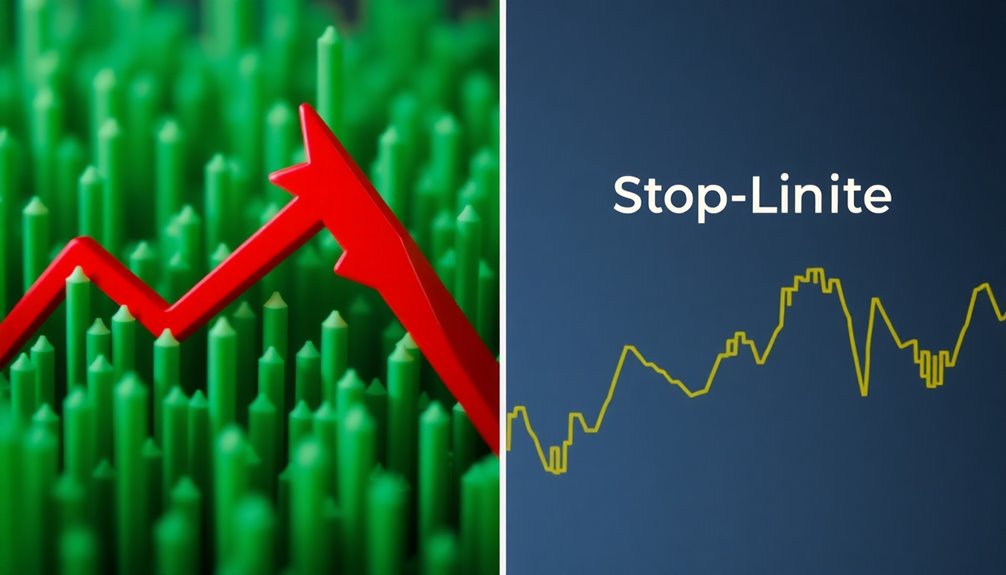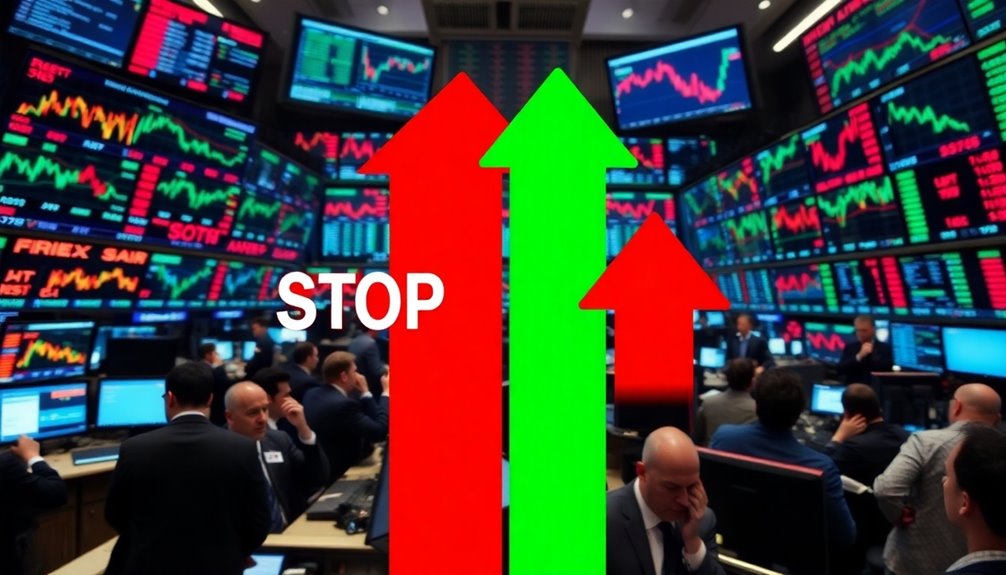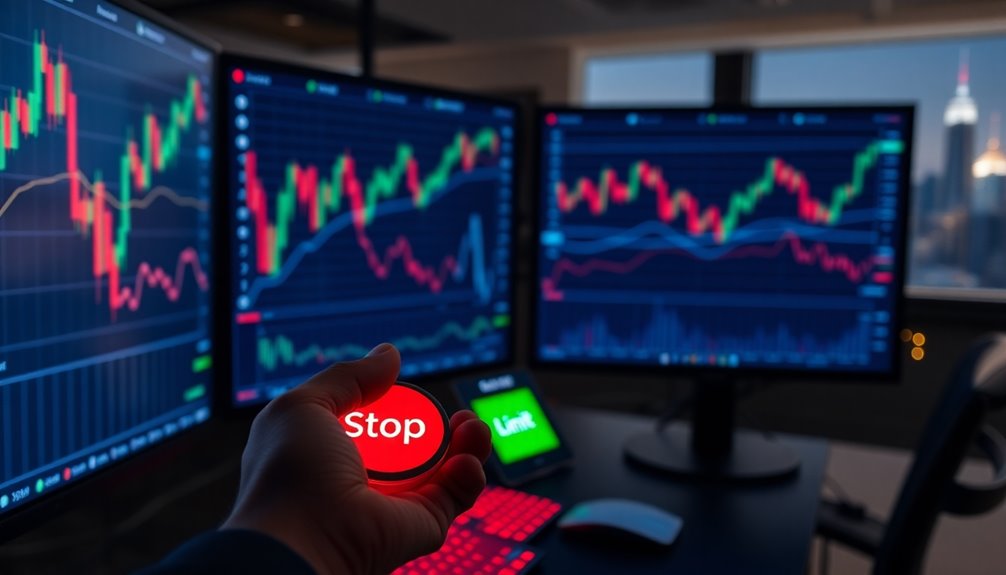The key difference between stop orders and stop-limit orders lies in execution. A stop order triggers a market order once it hits a specified stop price, ensuring that your order gets filled, albeit at the current market price, which could be unfavorable in volatile conditions. In contrast, a stop-limit order becomes a limit order at a designated limit price once the stop price is reached, giving you more control over the execution price but without a guarantee that it will fill. Understanding these mechanics helps you better navigate the risks in trading, and there's more to uncover about these strategies next.
Key Takeaways
- A stop order triggers a market order once the stop price is reached, ensuring immediate execution.
- A stop-limit order activates a limit order at a specified price when the stop price is triggered, allowing price control.
- Stop orders guarantee execution but may incur slippage; stop-limit orders risk non-execution if the market price exceeds the limit.
- Stop orders can result in unfavorable fills during high volatility, whereas stop-limit orders prevent selling below the desired price.
- Choosing between the two reflects a trader's risk management strategy and required execution certainty.
Order Types Explained

When you dive into trading, understanding order types is crucial, as it can significantly impact your strategy.
A stop order is designed to trigger a market order to buy or sell a security once the specified stop price is reached. This ensures immediate execution but doesn't guarantee the execution price, especially in volatile markets.
On the other hand, a stop-limit order combines a stop order with a limit order. It activates a limit order once the stop price is met, allowing you to control the execution price. However, there's a risk of non-execution if the market moves rapidly.
Knowing these differences can help you navigate price movement and make more informed trading decisions.
Order Types Overview

Understanding the various order types in trading is essential for effective decision-making, as each serves a specific purpose in managing your investments.
A stop order triggers a market order to buy or sell once the stock price hits a specified stop price, ensuring immediate execution at the best available market price.
In contrast, a stop-limit order activates a limit order once the stop price is reached but only trades at the specified limit price or better.
While stop orders guarantee execution, they don't guarantee the execution price, which can fluctuate.
Stop-limit orders allow for more control over pricing but carry the risk of non-execution.
Both types are crucial for risk management during trading sessions and can be part of your conditional trade strategy.
Order Execution Mechanics Explained

Order execution mechanics are vital for grasping how stop and stop-limit orders function in real-time trading scenarios.
A stop order converts to a market order once the specified stop price is reached, ensuring execution at the next available market price without a guarantee of that price. This method can protect against losses or help in capturing gains in fast-moving markets, though it may result in slippage.
In contrast, a stop-limit order becomes a limit order when triggered, allowing you to set a maximum execution price. However, this carries the risk of non-execution if the market price drops below your limit immediately after the trigger.
Understanding these mechanics helps you make informed decisions based on your risk tolerance and current market conditions.
Pros and Cons Overview

While both stop-loss and stop-limit orders have their unique advantages, it's essential to weigh their pros and cons based on your trading strategy.
A stop-loss order guarantees execution at market price, which is crucial for minimizing losses quickly, especially in fast-moving markets. However, it might trigger during a temporary dip, leading to unfavorable fills.
Conversely, a stop-limit order provides control over execution price by setting a limit, ensuring you don't sell below your desired price. The downside? You risk non-execution if the market price moves beyond your limit after the stop price is hit.
Ultimately, your choice should reflect your risk management approach and how precise you want to be with your exit points.
Stop Order vs. Stop-Limit

When deciding between a stop order and a stop-limit order, it helps to consider your trading goals and market conditions.
A stop order triggers a market order to buy or sell once the stop price is reached, ensuring immediate execution but exposing you to slippage. This makes it effective for loss protection in fast-moving markets.
On the other hand, a stop-limit order activates a limit order at a specified limit price once the stop price is hit, offering you greater price control but no guarantee of execution.
Traders often choose stop orders for aggressive exits and stop-limit orders for more strategic selling in less volatile conditions.
Understanding these differences can significantly impact your trading strategy.
Market Volatility Impacts Execution

Market volatility can dramatically affect how your stop and stop-limit orders get executed, so understanding this dynamic is essential for effective trading.
During high volatility, stop orders convert to market orders when triggered, ensuring execution but potentially leading to slippage, where the execution price can differ significantly from your stop price.
On the other hand, stop-limit orders turn into limit orders and may not execute if the market price quickly moves past your limit price.
Price fluctuations and gaps can cause stop orders to execute at unfavorable prices, while stop-limit orders risk non-execution altogether.
Emerging Technologies in Trading

As trading evolves, emerging technologies are reshaping how traders execute strategies and manage risks.
You'll find algorithmic trading systems leveraging complex models and high-frequency trading platforms that enhance market efficiency by executing orders in milliseconds.
Artificial intelligence and machine learning are transforming trading strategies, enabling real-time data analysis and predictive modeling to spot trends and optimize decisions.
Decentralized finance (DeFi) platforms are revolutionizing trading by reducing transaction costs and increasing transparency through peer-to-peer interactions.
Robo-advisors democratize investment management, providing automated services for all wealth levels.
Additionally, immersive trading environments created by virtual and augmented reality technologies allow you to visualize data and market trends in innovative ways, enhancing your analytical capabilities.
Utilize Trailing Stop Orders

Trailing stop orders can be a powerful tool for maximizing profits while managing risk in your trading strategy.
These orders automatically adjust the stop price based on a fixed percentage or dollar amount below the market price, locking in profits and providing downside protection.
Unlike traditional stop orders, trailing stop orders only activate when the market price moves favorably, capturing more gains as prices rise. This type of order adjusts dynamically with the asset’s price, allowing investors to lock in profits while still maintaining the potential for further upside. To better understand this strategy, it’s helpful to look at the trailing stop order definition, which describes it as a conditional order designed to protect gains by enabling a trade to remain open and continue to profit as long as the market price is moving in a favorable direction. If the price reverses by a specified amount, the order will trigger, ensuring that profits are secured.
They can be set as a market order or limit order, depending on your preference.
In volatile markets, they ensure profit protection while allowing for upward movement.
You can customize trailing stops according to your risk tolerance, making them a flexible tool in your trading approach.
Embrace trailing stop orders to enhance your trading effectiveness.
Frequently Asked Questions
Which Is Better Stop or Stop Limit?
When you're caught in a whirlwind of trading options, choosing between stop and stop-limit orders can feel like deciding between a rocket or a balloon!
If you want quick execution, go with stop orders—they'll launch your trade at the next available price.
But if you crave control over your price, stop-limit orders are your safety net, though they might leave you hanging if the market moves too fast.
It all boils down to your trading style!
What Is an Example of a Stop Limit?
A stop-limit order helps you manage your trades more effectively.
For instance, let's say you own shares priced at $60. You set a stop price at $55 and a limit price at $53.
If the stock drops to $55, your order activates, but it'll only execute if the price is $53 or higher.
This way, you maintain control over your selling price, but be careful—there's a risk you might miss the execution.
What Are the Disadvantages of a Stop Limit Order?
Imagine holding a fragile glass sculpture, carefully balancing it on a tightrope. That's how a stop-limit order feels.
You're at risk of missing opportunities if the market moves quickly, as your order mightn't execute. During volatile times, price jumps can leave your order unfilled, making you cling to losing positions.
Plus, you need to monitor it closely, or you could find your plans shattered when market conditions don't align.
Can You Have a Stop and Limit Order at the Same Time?
Yes, you can place both a stop order and a stop-limit order at the same time for the same security.
This strategy allows you to manage your trades more effectively. For instance, you can use the stop order to limit potential losses, while the stop-limit order helps secure profits at a specific price.
Just make sure to monitor both closely, as market conditions can change rapidly and impact their execution.
Conclusion
In summary, understanding the difference between stop and stop-limit orders can significantly enhance your trading strategy. Did you know that nearly 70% of all market orders are executed at prices that deviate from the expected due to market volatility? This highlights the importance of choosing the right order type. By knowing when to use stop or stop-limit orders, you can better navigate the unpredictable waters of trading and potentially safeguard your investments more effectively.









